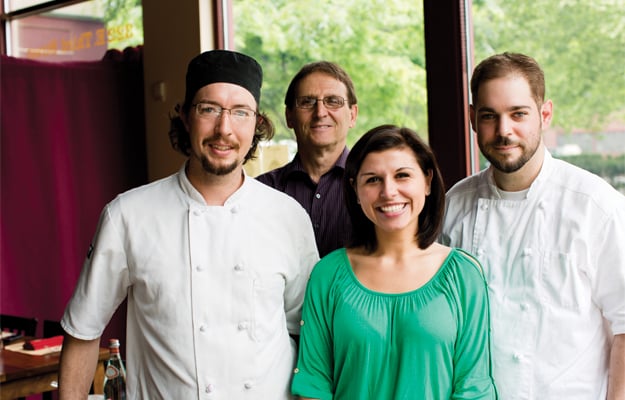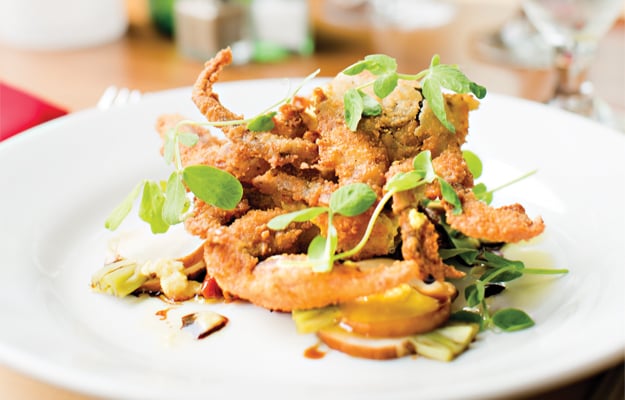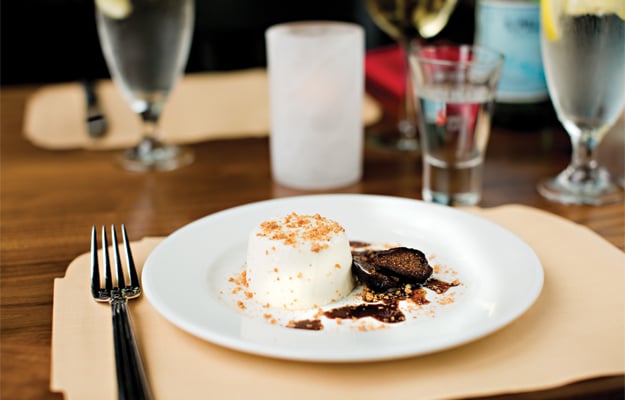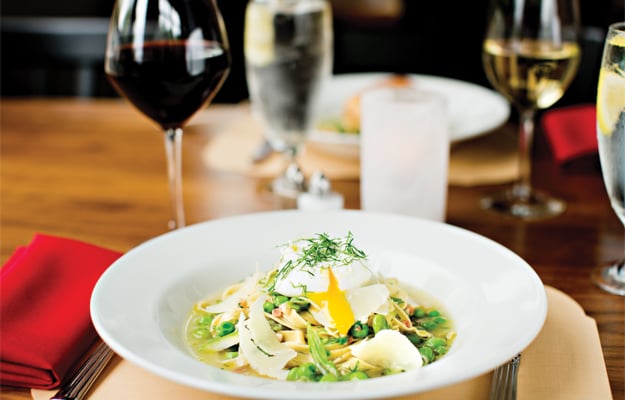
We have all experienced 1,001 Italian-American restaurants, with red and white checkered tablecloths laden with glass shakers of red pepper, Parmesan, oregano, pre-sliced garlic bread and entrées ample enough for a small army. They are generally crowd pleasers and, when done well, give everyone at the table plenty of options.
But sometimes, that's not what you want. Sometimes you want the transcendent bowl of pasta that you ate in Florence on the piazza, with the chatter of conversational Italian bubbling around you, and local, unforgettable (and hard to get) red wine. Enter Molinari's.
The view is of the beautiful, decaying, hulking Steel, but the food is authentically Italian. Although there may not be a spouting fountain, there is outdoor seating.
There are a lot of stories to tell about Molinari's, and how it came to be. You could say that it's the story of a chef who woke up one morning and walked away from a plum job after being possessed by a dream he had that sent him back home to Bethlehem. You could say it's the story of an accountant, guided by his faith, who opened a restaurant because wanted to give back to those less fortunate, halfway around the world. You could say both of those things, and they would be true. The most important take-home message, however, is that Molinari's is guided by a love of Italian food—the kind you're more likely to have in Italy than in Any Town, U.S.A.
Like many Italian restaurants, Molinari's, which opened right after Thanksgiving 2011, bears the namesake of the family. Dad Fran owns the business; his daughter Anna, fourth of five children, serves as assistant manager; and older sister Leah works as a hostess on the weekends. The idea to start a restaurant, however, came out of the blue, as Anna tells it. “I was working in Virginia, and my dad just called me and told me he wanted to open a restaurant. I was shocked.” Of the three sisters, she was a natural fit to be most closely involved in the project, having worked in restaurants since she was 14 or 15. Although their last name may end in a vowel, they're not 100 percent Italian-American. “We're also German, but the Italian part seems to run much thicker,” says Anna. (Don't tell the German blood.)

Guided by love—what else is there when it comes to food?—the Molinaris set out to find the perfect chef. Rewind to 2008, when their current chef, Michael Joyce, returned to his hometown, Bethlehem. Like many people who grow up in a small town or city, Joyce couldn't wait to explore what else the world offered. He says he wasn't terribly interested in college, but there was no choice; he comes from a long line of mechanical engineers, and was urged, like his father, to go to Penn State. He did, but he enrolled in the hotel and restaurant management program; culinary school hadn't occurred to him as a career path at that point, even though he says his restaurant career began at Gregory's Steakhouse as a busboy when he was 14. “I always found my way into a kitchen; kitchens grab me,” he says.
During and after graduation from Penn State in 2001, Joyce worked for Chef David Robinson at Zola New World Bistro for two years. He then moved on to what would become the award-winning kitchen of Chef Christopher Lee at Striped Bass (now closed) in Philadelphia. But Italy beckoned, so after he left Striped Bass, armed with his backpack and a drained savings account (he even sold his Toyota), Joyce went to Italy for four months. Yes, it sounds like a cliché, but he did it. With little agenda, Joyce slept in hostels, sampled everything you're supposed to while you're there, and drank the wine—grappa, limoncello, you name it. He ate at the first pizzeria in Naples, Antica Pizzeria Port'Alba, sampled 25-year-old balsamic vinegar in Modena, and describes the flavor as “tart, woody, sweet—unlike anything most Americans have tasted here.” The white truffle festival in Piedmont entranced him, and he spent time in vineyards in Tuscany, eating the prosciutto, olive oil, pecorino, and drinking the wine all made on premises. The experience, as one might imagine, was transformative.
Joyce returned home, newly invigorated and even more committed to the ethos of farm-to-table cuisine, and sought out Dan Barber at the seminal Stone Barns in upstate New York, known for supplying its restaurant Blue Hill in New York City with seasonal produce. “I just sent him an email,” Joyce says. He was on the cusp of becoming the sous chef at its second location, Blue Hill at Stone Barns, but one morning, he woke up from a dream and felt he could not do it; he was overcome with this inexplicable urge to return home.
When asked what the dream was about, he says he doesn't even really remember—he just knew he had to come back to Bethlehem. With no employment lined up, he went back to his roots, and soon, with his enviable farm-to-table experience at Blue Hill, Bolete snapped him up a few months after the restaurant opened. He stayed there for three years until Molinari's opened, then brought with him from Bolete his good friend and current sous chef, Erik Hoffman. You might say that Joyce was born for this job—he too, comes from an Italian family, complete with a Sicilian grandmother. But this is really no surprise at this point, right?

The experience in Italy changed his palate in ways that that the diners of Molinari's will forever be indebted to, even if they might not realize it. What diners will realize, however, is that the menu at Molinari's is a well-edited, precise and varied representation of Italian food. It presents a balance of imported (always San Marzano tomatoes: “that volcanic soil produces amazing tomatoes,” Joyce says) and local, such as eggs from Happy Farms; greens from Liberty Gardens,
and as summer unfolds, as many local veggies as possible. Joyce says that Americans are most familiar with southern Italian cooking, but Italy's cuisine is diverse and influenced by the countries that surround it, and its own history and immigration patterns. “We wanted to show people that there's a lot more out there to Italian cooking than red sauce and Parmesan,” he says. “There are whole other parts of the country with German and French influences, and of course Sicily, with its northern African influences. Italy is almost like 20 different countries.”
Inherent, too, in Italian cooking, is the desire to use seasonal and local ingredients for the freshest taste. After all, it was the birthplace of the Slow Food movement, and a place that feels mythological to many Americans for its leisurely, food-indulging, sun-dappled way of life. There's no need to distinguish it with specific nomenclature, as we have to in this country, as farm-to-table cuisine. “That's just the way it is there; it naturally changes with the cycles of the season,” he says. This results in spring dishes such as the appetizer I sampled, a Keepsake Farm Ricotta Crostini (the crostini always changes), with three slices of bread (from nearby Flour Shop; focaccia is house made), brushed with lemon olive oil and topped with the essence of spring: vibrant English pea pesto, pea shoots and pickled ramps. Seasonal foods show up in the fettuccine mola, a bright riot of green: English peas, fava beans, gently topped with a perfectly poached egg. The curling tendrils of pasta receive substantive shards of Parmesan (much more effective than wispy shreds) and sit atop a scattering of pancetta (surprise!) in a spring garlic and Parmesan broth.
Joyce's experiences mirror those of what the Molinari family had while traveling in Italy. “I couldn't believe the flavors, the food pairings, the meats and the cheeses. What is this amazing food I've never had before?” Anna says. She and her extended family had been visiting Anna's older sister Elle, who was working as an au pair for an Italian family. Clearly, the Molinaris and Joyce are bonded by their love of Italian food. “I have dreams about the budino,” Anna says rapturously of their big selling dark chocolate dessert: a pudding with espresso cream and a hazelnut and sea salt crumble. (I was more than partial to the honey panna cotta, with figs and a saba—a reduced grape juice commonly used as a sweetener in Italy.)

It's the first venture into restaurants for the family, and it's come with some learning curves. “I've learned I have to communicate—and even over-communicate—with everyone, the chefs, the servers, etc.” Whenever he can, dad Fran is on the premises, “Doing anything and everything,” she says. “Right now he's learning to bartend, and I just look over there and think—that's my dad bartending,” says Anna, laughing and shaking her head.
However, the family made some wise staffing decisions, with Joyce in the kitchen and general manager Marco Carrozza, with decades of experience in Philadelphia, Bucks County and, before Molinari's, as the corporate chef at Fegley's Brew Works.
They also spared no expense in procuring the best tools for the job, including a wood-fired oven that takes four hours to heat to 800° Fahrenheit (from 400°) and then two to four minutes for each pizza; a Carpigiani, “the Cadillac of gelato makers,” which produces six different gelato flavors in 11 minutes; and an Arcobaleno pasta maker, with all the special extruders you'd need for authentic pasta. And we haven't even talked about the special wine list with hard-to-find bottles and the unparalleled selection of Italian beers—yes, Italy makes beers beyond Peroni and Moretti. Italy is undergoing something of a craft beer renaissance, with brewers making Belgian-styled ales and witbiers and English-styled barleywines and so forth. The Le Baladin Al-ilksir, a 10 percent ale, was low in carbonation, slightly sweet with a honey mead aroma, and worth seeking out.
”If you come in here once, it's done. You come back because of what Mike and everyone we have in the kitchen [creates]. He was a Godsend,” Anna says. She means that sincerely. Faith is important to the family. Inspired by Tom's Shoes, Fran decided that the slogan would be “where your hunger has a heart,” and so they'll donate two percent of their receipts to orphanages in Haiti and Zambia. They're not in it for the flash, the cash or the buzz.
The other part of their objective is articulated in a way that's a bit uncommon. “We also wanted to have great food to facilitate great relationships. We want to give you an experience that facilitates whatever relationship you are having at the table. We want to put food in front of you that stimulates you. Italian food is supposed to be eye popping, lip smacking,” Anna says.
Joyce adds, “Whatever we're making, just make it perfect.” With those ideals in the kitchen, it's unlikely you'll have an experience that's anything less than that.















